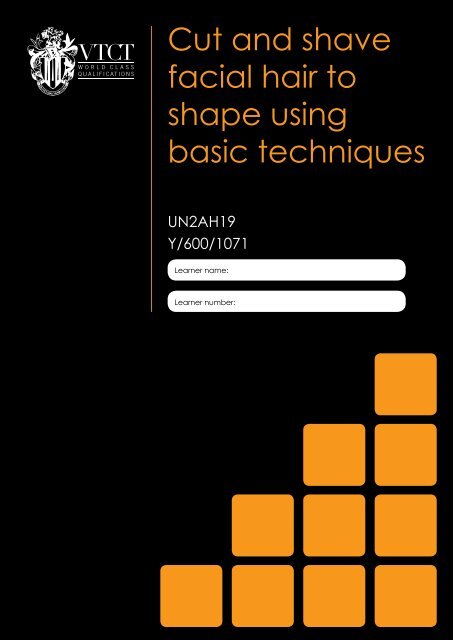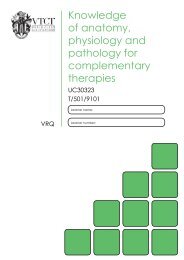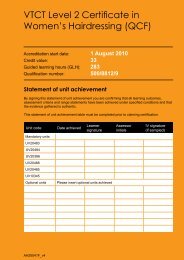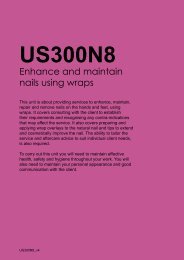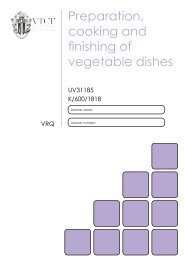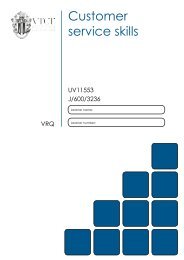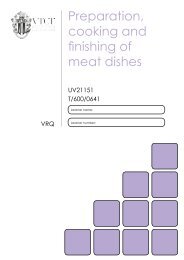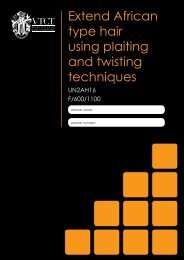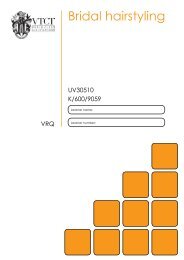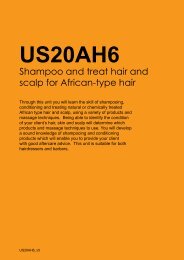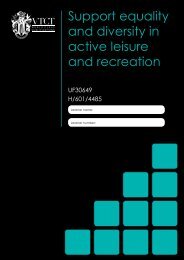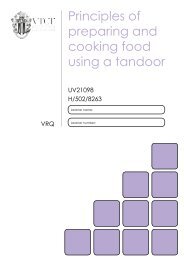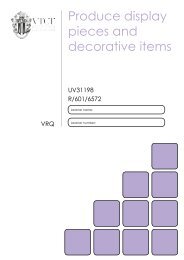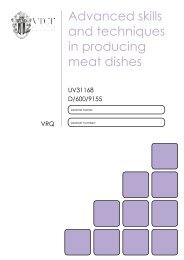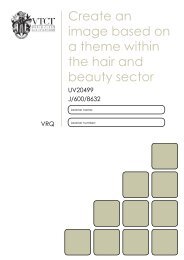UN2AH19 - VTCT
UN2AH19 - VTCT
UN2AH19 - VTCT
Create successful ePaper yourself
Turn your PDF publications into a flip-book with our unique Google optimized e-Paper software.
Cut and shave<br />
facial hair to<br />
shape using<br />
basic techniques<br />
<strong>UN2AH19</strong><br />
Y/600/1071<br />
Learner name:<br />
Learner number:
Statement of unit achievement<br />
<strong>VTCT</strong> is the specialist awarding body for the Hairdressing, Beauty Therapy,<br />
Complementary Therapy and Sport and Active Leisure sectors, with over 45<br />
years of experience.<br />
<strong>VTCT</strong> is an awarding body regulated by national organisations including<br />
Ofqual, SQA, DCELLS and CCEA.<br />
<strong>VTCT</strong> is a registered charity investing in education and skills but also giving to<br />
good causes in the area of facial disfigurement.<br />
By signing this statement of unit achievement you are confirming that all learning outcomes, assessment<br />
criteria and range statements have been achieved under specified conditions and that the evidence<br />
gathered is authentic.<br />
This statement of unit achievement table must be completed prior to claiming certification.<br />
Unit code Date achieved Learner signature<br />
Assessor tracking table<br />
Assessor name Assessor signature<br />
Assessor<br />
initials<br />
Assessors<br />
initials<br />
IV signature<br />
(if sampled)<br />
All assessors using this Record of Assessment book must complete this table. This is required for<br />
verification purposes.<br />
Assessor number<br />
(optional)
<strong>UN2AH19</strong><br />
Cut and shave facial hair to<br />
shape using basic techniques<br />
Through this unit you will develop the ability to reshape<br />
beards and moustaches on African type hair. Being able to<br />
identify the condition of your client’s face, skin and facial<br />
hair will determine which products, tools and techniques<br />
to use. You will develop a sound knowledge of suitable<br />
products for home use which will enable you to provide<br />
your client with good aftercare advice.<br />
<strong>UN2AH19</strong>_v4
NOS<br />
AH19<br />
Level<br />
Credit value<br />
GLH<br />
2<br />
4<br />
40<br />
Observations<br />
3<br />
External paper(s)<br />
1<br />
© Habia
Cut and shave facial hair to<br />
shape using basic techniques<br />
Learning outcomes Evidence requirements<br />
On completion of this unit you will:<br />
1. Be able to use safe and effective methods of<br />
working when cutting facial hair<br />
2. Be able to cut and shave beards and<br />
moustaches to maintain their shape<br />
3. Understand salon and legal requirements<br />
4. Understand how to work safely, effectively<br />
and hygienically when cutting facial hair<br />
5. Understand how to use tools and equipment<br />
6. Understand factors that affect facial hair<br />
cutting and shaving techniques<br />
7. Understand the aftercare advice to provide<br />
for clients<br />
1. Simulation is not allowed for any<br />
performance evidence within this unit.<br />
2. You must practically demonstrate in your<br />
everyday work that you have met the<br />
standard for cutting and shaving facial hair.<br />
3. Your assessor will observe your<br />
performance on at least 3 occasions, 1<br />
of which must include the reshaping of<br />
a full beard and 1 of the creation of a<br />
moustache.<br />
4. From the range, you must show that you<br />
have:<br />
• used all the types of tools and<br />
equipment listed<br />
• taken account of all the factors listed<br />
• cut all the looks listed<br />
• used all the cutting and shaving<br />
techniques listed<br />
• given all the types of advice listed.<br />
5. It is most likely evidence of your<br />
performance will be gathered from the<br />
observations made by your assessor but<br />
you may be required to produce other<br />
evidence to support your performance if<br />
your assessor has not been present.<br />
6. Knowledge and understanding in this unit<br />
will be assessed by an external paper.<br />
The criteria that make up this paper are<br />
highlighted in white throughout this unit.<br />
There is one external paper that must be<br />
achieved.<br />
<strong>UN2AH19</strong><br />
3
4<br />
Achieving observations<br />
and range<br />
Achieving observation outcomes<br />
Your assessor will observe your performance<br />
of practical tasks. The minimum number<br />
of observations required is indicated in the<br />
evidence requirements section of this unit.<br />
Criteria may not always naturally occur during<br />
a practical observation. In such instances you<br />
will be asked questions to demonstrate your<br />
competence in this area. Your assessor will<br />
document the criteria that have been achieved<br />
through oral questioning.<br />
Your assessor will sign off an outcome when all<br />
criteria have been competently achieved in a<br />
single client service.<br />
Achieving range<br />
The range section indicates what must<br />
be covered. Ranges must be practically<br />
demonstrated as part of an observation. Your<br />
assessor will document the portfolio reference<br />
once a range has been competently achieved.<br />
<strong>UN2AH19</strong><br />
Maximum service times<br />
The following maximum service times apply to<br />
this unit:<br />
Tapered beardline<br />
(trim) 10 minutes<br />
Full beard outlines<br />
(trim) 10 minutes<br />
Rooftop moustache<br />
(trim) 5 minutes<br />
(create) 10 minutes<br />
Pencil moustache<br />
(trim) 5 minutes<br />
(create) 10 minutes<br />
Lipline moustache<br />
(trim) 5 minutes<br />
(create) 10 minutes
Outcome 1<br />
You can:<br />
a. Protect the client’s clothing and keep<br />
their eyes and neck free of hair cuttings<br />
throughout the service<br />
b. Keep the work area clean and tidy<br />
throughout the service<br />
c. Remove waste immediately at the end of<br />
the cutting service<br />
d. Use working methods that:<br />
- minimise the risk of damage to tools<br />
and equipment<br />
- minimise the risk of cross-infection<br />
- minimise the waste of products<br />
- make effective use of the working time<br />
- ensure the use of clean resources<br />
- minimise harm or injury to yourself<br />
and others<br />
e. Maintain personal standards of health<br />
and hygiene which minimise the risk of<br />
cross-infection, infestation and offence to<br />
clients and colleagues<br />
*May be assessed through oral questioning.<br />
Observations<br />
Be able to use safe and effective methods of working when<br />
cutting facial hair<br />
f. Identify factors likely to influence the service<br />
prior to cutting *<br />
g. Complete the cutting service within a<br />
commercially viable time<br />
Observation<br />
Criteria questioned orally<br />
Date achieved<br />
Portfolio reference<br />
Learner signature<br />
Assessor initials<br />
1 2 3<br />
<strong>UN2AH19</strong><br />
5
6<br />
Photo courtesy of Wahl (UK) Ltd.<br />
Outcome 2<br />
Be able to cut and shave beards and moustaches to maintain<br />
their shape<br />
You can:<br />
a. Prepare the client’s facial hair prior to the<br />
service<br />
b. Confirm the client’s satisfaction with the<br />
agreed look at consultation, during and on<br />
completion of the service<br />
c. Establish and follow the beard guideline(s)<br />
to achieve the required look<br />
d. Use cutting and shaving techniques which<br />
take account of the influencing factors to<br />
achieve the desired look<br />
e. Position yourself and the client to help<br />
ensure the accuracy of the cut<br />
f. Achieve a finished look that is even,<br />
symmetrical and balanced in relation to the<br />
client’s facial contour and of an even density<br />
throughout the shape<br />
g. Remove any unwanted hair outside the<br />
desired outline shape<br />
h. Give the client suitable aftercare advice on<br />
the maintenance of the look<br />
*May be assessed through oral questioning.<br />
Observation 1 2 3<br />
Criteria questioned orally<br />
Date achieved<br />
Portfolio reference<br />
Learner signature<br />
Assessor initials<br />
<strong>UN2AH19</strong>
You must practically demonstrate that you have:<br />
Range<br />
Used all the types of tools and equipment Portfolio reference<br />
Scissors<br />
Clippers<br />
Clipper attachments<br />
T-liner<br />
Rotary mesh razor<br />
Pivot mesh razor<br />
Taken account of all the factors Portfolio reference<br />
Hair growth patterns<br />
In-growing hair<br />
Skin disorders<br />
Beard density<br />
Facial piercing<br />
Facial contours<br />
Client wishes<br />
<strong>UN2AH19</strong> 7
8<br />
Range<br />
You must practically demonstrate that you have:<br />
Cut all the looks listed Portfolio reference<br />
Tapered beardline<br />
Maximum service time to trim a beard 10 minutes<br />
Full beard outlines<br />
Maximum service time to trim beard a 10 minutes<br />
Rooftop moustache<br />
Maximum service time to trim a moustache 5 minutes<br />
Maximum service time to create a moustache 10 minutes<br />
Pencil moustache<br />
Maximum service time to trim a moustache 5 minutes<br />
Maximum service time to create a moustache 10 minutes<br />
Lipline moustache<br />
Maximum service time to trim a moustache 5 minutes<br />
Maximum service time to create a moustache 10 minutes<br />
Used all the cutting and shaving techniques Portfolio reference<br />
Scissors over comb<br />
Clipper with attachment<br />
Clipper over comb<br />
Freehand<br />
Dry shave<br />
Skin tensioning<br />
Ear hair cutting<br />
Eyebrow cutting<br />
Given all the types of advice Portfolio reference<br />
Time between cuts<br />
Maintenance of beard shapes<br />
Suitable homecare equipment<br />
<strong>UN2AH19</strong>
Achieving knowledge outcomes<br />
You will be guided by your tutor and assessor<br />
on the evidence that needs to be produced.<br />
Your knowledge and understanding will be<br />
assessed using the assessment methods listed<br />
below:<br />
• Observed work<br />
• Witness statements<br />
• Audio-visual media<br />
• Evidence of prior learning or attainment<br />
• Written questions<br />
• Oral questions<br />
• Assignments<br />
• Case studies<br />
Achieving the external paper<br />
Developing knowledge<br />
Where possible your assessor will integrate<br />
knowledge outcomes into practical observations<br />
through oral questioning.<br />
The external paper will test your knowledge of the criteria highlighted in white. A pass mark of<br />
70% must be achieved. Criteria not achieved will be identified to your tutor/assessor. You will<br />
then be orally questioned or asked to produce other forms of evidence as all unit criteria must be<br />
achieved.<br />
Your assessor will complete the table below when the 70% pass mark has been achieved.<br />
Paper Date achieved Assessor initials<br />
1 of 1<br />
<strong>UN2AH19</strong> 9
10<br />
Knowledge<br />
Outcome 3<br />
Understand salon and legal requirements<br />
You can:<br />
a. Describe the salon’s requirements for client preparation<br />
b. Describe the salon's expected service times for cutting facial hair<br />
to shape<br />
c. Describe the salon’s and legal requirements for disposal of waste<br />
materials<br />
d. Describe own responsibilities under the current Electricity at Work<br />
Regulations<br />
e. Identify any limitations placed on the use of razors by local by-laws<br />
and legislation<br />
* Assessor initials to be inserted if orally questioned.<br />
Requirements highlighted in white are assessed in the external paper.<br />
<strong>UN2AH19</strong><br />
Portfolio reference /<br />
Assessor initials*
Outcome 4<br />
Understand how to work safely, effectively and hygienically<br />
when cutting facial hair<br />
You can:<br />
a. List the protective equipment that should be available<br />
b. Explain why it is important to protect clients from hair clippings<br />
c. Describe how the position of the client and yourself can affect the<br />
desired outcome and reduce fatigue and the risk of injury<br />
d. Identify the safety considerations which must be taken into account<br />
when cutting facial hair<br />
e. Explain why it is important to avoid cross-infection and infestation<br />
f. Explain why it is important to keep the work area clean and tidy<br />
g. Compare the methods of cleaning, disinfecting and sterilisation<br />
used in barber shops<br />
h. Describe methods of working safely and hygienically and which<br />
minimise the risk of cross-infection and cross-infestation<br />
i. Explain the importance of maintaining personal hygiene<br />
* Assessor initials to be inserted if orally questioned.<br />
Requirements highlighted in white are assessed in the external paper.<br />
Portfolio reference /<br />
Assessor initials*<br />
<strong>UN2AH19</strong> 11
12<br />
Photo courtesy of Wahl (UK) Ltd.<br />
Outcome 5<br />
Understand how to use tools and equipment<br />
You can:<br />
a. Describe methods of cleaning and maintaining tools and<br />
equipment<br />
b. Explain how to safely use tools and equipment<br />
c. Explain how to level and test clippers<br />
d. Explain the size of clipper blades and attachments available and<br />
the effects that these achieve<br />
* Assessor initials to be inserted if orally questioned.<br />
Requirements highlighted in white are assessed in the external paper.<br />
<strong>UN2AH19</strong><br />
Portfolio reference /<br />
Assessor initials*
Outcome 6<br />
Understand factors that affect facial hair cutting and shaving<br />
techniques<br />
You can:<br />
a. Describe the factors that must be taken into consideration prior<br />
to cutting (including hair growth patterns, in-growing hair, skin<br />
disorders, beard density, facial piercing, facial contours, client<br />
wishes) and how they can affect the way the facial hair is cut and<br />
shaved<br />
b. Explain the importance of cutting the beard outline to follow the<br />
contours of the face<br />
c. Describe how to neaten beards<br />
d. Describe how to create basic moustache shapes<br />
e. Explain the importance of consulting with clients throughout the<br />
cutting process<br />
f. Explain when to cut facial hair using freehand, scissors over comb,<br />
clipper with attachment and clipper over comb cutting techniques<br />
g. Explain the reasons for establishing and following outlines<br />
h. Describe methods of working to create a symmetrical and balanced<br />
look<br />
i. Explain the importance of considering density and working with the<br />
natural growth patterns of the facial hair<br />
j. Compare the result of cutting against and with the natural hair<br />
growth direction<br />
k. State the average rate of hair growth<br />
l. Describe the effects of continual close cutting on black skin<br />
m. Explain the potential risk of in-growing hair resulting from continual<br />
close cutting<br />
* Assessor initials to be inserted if orally questioned.<br />
Requirements highlighted in white are assessed in the external paper.<br />
Portfolio reference /<br />
Assessor initials*<br />
<strong>UN2AH19</strong> 13
14<br />
Photo courtesy of Wahl (UK) Ltd.<br />
Outcome 7<br />
Understand the aftercare advice to provide for clients<br />
You can:<br />
a. State the recommended time interval between cuts<br />
b. Explain how the hair texture affects styling possibilities<br />
c. Describe the maintenance requirements for beards and<br />
moustaches<br />
d. Describe the equipment and products to use for home care and<br />
those to avoid and why<br />
e. Explain how to give effective advice and recommendations to<br />
clients<br />
* Assessor initials to be inserted if orally questioned.<br />
Requirements highlighted in white are assessed in the external paper.<br />
<strong>UN2AH19</strong><br />
Portfolio reference /<br />
Assessor initials*


